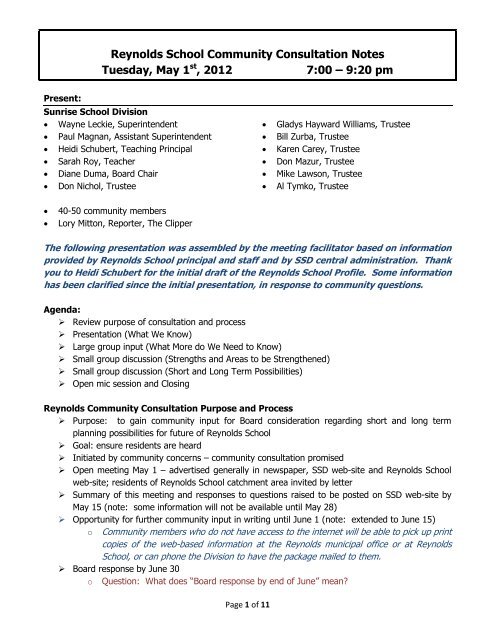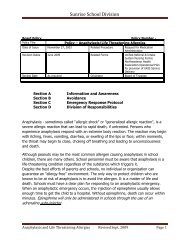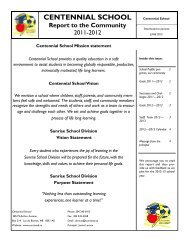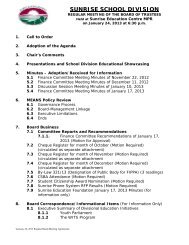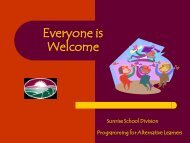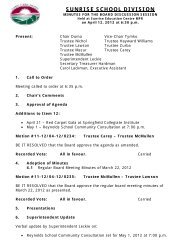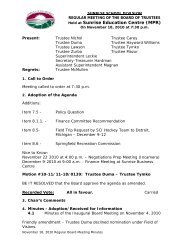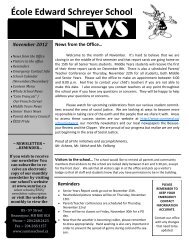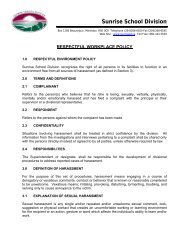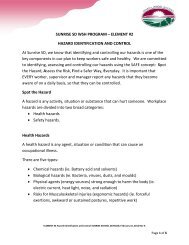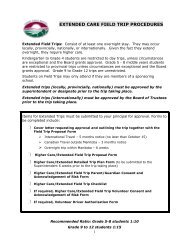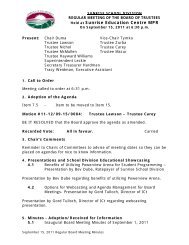Summary of May 1 Meeting - Sunrise School Division
Summary of May 1 Meeting - Sunrise School Division
Summary of May 1 Meeting - Sunrise School Division
Create successful ePaper yourself
Turn your PDF publications into a flip-book with our unique Google optimized e-Paper software.
Reynolds <strong>School</strong> Community Consultation Notes<br />
Tuesday, <strong>May</strong> 1 st , 2012<br />
7:00 – 9:20 pm<br />
Present:<br />
<strong>Sunrise</strong> <strong>School</strong> <strong>Division</strong><br />
Wayne Leckie, Superintendent<br />
Paul Magnan, Assistant Superintendent<br />
Heidi Schubert, Teaching Principal<br />
Sarah Roy, Teacher<br />
Diane Duma, Board Chair<br />
Don Nichol, Trustee<br />
<br />
<br />
<br />
<br />
<br />
<br />
Gladys Hayward Williams, Trustee<br />
Bill Zurba, Trustee<br />
Karen Carey, Trustee<br />
Don Mazur, Trustee<br />
Mike Lawson, Trustee<br />
Al Tymko, Trustee<br />
<br />
<br />
40-50 community members<br />
Lory Mitton, Reporter, The Clipper<br />
The following presentation was assembled by the meeting facilitator based on information<br />
provided by Reynolds <strong>School</strong> principal and staff and by SSD central administration. Thank<br />
you to Heidi Schubert for the initial draft <strong>of</strong> the Reynolds <strong>School</strong> Pr<strong>of</strong>ile. Some information<br />
has been clarified since the initial presentation, in response to community questions.<br />
Agenda:<br />
‣ Review purpose <strong>of</strong> consultation and process<br />
‣ Presentation (What We Know)<br />
‣ Large group input (What More do We Need to Know)<br />
‣ Small group discussion (Strengths and Areas to be Strengthened)<br />
‣ Small group discussion (Short and Long Term Possibilities)<br />
‣ Open mic session and Closing<br />
Reynolds Community Consultation Purpose and Process<br />
‣ Purpose: to gain community input for Board consideration regarding short and long term<br />
planning possibilities for future <strong>of</strong> Reynolds <strong>School</strong><br />
‣ Goal: ensure residents are heard<br />
‣ Initiated by community concerns – community consultation promised<br />
‣ Open meeting <strong>May</strong> 1 – advertised generally in newspaper, SSD web-site and Reynolds <strong>School</strong><br />
web-site; residents <strong>of</strong> Reynolds <strong>School</strong> catchment area invited by letter<br />
‣ <strong>Summary</strong> <strong>of</strong> this meeting and responses to questions raised to be posted on SSD web-site by<br />
<strong>May</strong> 15 (note: some information will not be available until <strong>May</strong> 28)<br />
‣ Opportunity for further community input in writing until June 1 (note: extended to June 15)<br />
o Community members who do not have access to the internet will be able to pick up print<br />
copies <strong>of</strong> the web-based information at the Reynolds municipal <strong>of</strong>fice or at Reynolds<br />
<strong>School</strong>, or can phone the <strong>Division</strong> to have the package mailed to them.<br />
‣ Board response by June 30<br />
o Question: What does “Board response by end <strong>of</strong> June” mean?<br />
Page 1 <strong>of</strong> 11
• The open meeting was an opportunity for community members to raise<br />
questions they feel are important for the Board to consider when planning for<br />
the future <strong>of</strong> Reynolds <strong>School</strong>. By June 30, the Board will confirm staffing for<br />
2012-13 and will indicate its short term planning considerations and commitment<br />
to developing a longer term plan for Reynolds <strong>School</strong>.<br />
Reynolds <strong>School</strong> Pr<strong>of</strong>ile<br />
Reynolds <strong>School</strong> 2011-12 Student Enrolment<br />
Grade # <strong>of</strong> Students<br />
Kindergarten 2<br />
Grade One 0<br />
Grade Two 0<br />
Grade Three 3<br />
Grade Four 1<br />
Grade Five 2<br />
Grade Six 4<br />
Total Enrolment 12<br />
Current and Projected Enrolment (based on local knowledge <strong>of</strong> current community<br />
composition)<br />
GRADE 2011-12 2012-13 2013-14 2014-15<br />
Kindergarten 2 2 4 6<br />
Grade One 0 2 2 4<br />
Grade Two 0 0 2 2<br />
Grade Three 3 0 0 2<br />
Grade Four 1 3 0 0<br />
Grade Five 2 1 3 0<br />
Grade Six 4 2 1 3<br />
TOTAL 12 10 12 17<br />
Possible Impacts <strong>of</strong> a Small <strong>School</strong>:<br />
http://www.edu.gov.mb.ca/k12/docs/reports/rural_ed/rural_ed_final.pdf<br />
‣ Class sizes<br />
‣ Learning environment<br />
‣ Social environment<br />
‣ Administrative<br />
‣ Opportunities for student growth<br />
‣ Communication with stakeholders (parents, community groups, local businesses and government)<br />
‣ <strong>School</strong>-community influence<br />
‣ Finance<br />
‣ Supportive programming<br />
‣ Student services<br />
‣ Transportation<br />
Page 2 <strong>of</strong> 11
Reynolds’ Academic Programs:<br />
‣ Writer’s Workshop<br />
‣ Totally Unique Speakers Club<br />
‣ Debate<br />
‣ Destination Imagination<br />
‣ Reading (e.g. Buddy Reading, Precision Reading)<br />
‣ Sharing and Journals<br />
‣ Letterland Program<br />
‣ AIM (French)<br />
‣ Math games and centers<br />
‣ Spiral-multiage curriculum (definition below)<br />
‣ Thematic, integrated units<br />
Multiage Education:<br />
“…All children may work on the same topic but in different ways or at their own individual speed.<br />
Learning to read, for example, progresses on an identifiable continuum. Children are measured against<br />
themselves in determining their growth toward a goal along that continuum.“<br />
Bingham, Dorta, McClaskey, and O'Keefe. Exploring the Multiage Classroom. York, ME: Stenhouse<br />
Publishers, 1995 (pps 7-8)<br />
‣ Allows for differentiated instruction to meet student needs.<br />
Multiage Education at Reynolds (2011-12 classes: K-4 n=6 Grade 5/6 n= 6)<br />
‣ All students have the right to learn at their own pace in a family-like learning environment<br />
‣ Teachers teach to the students in his/her class based on individual students’ capabilities. This<br />
means education is individualized to optimize growth and potential for each student.<br />
‣ Students in multiage program intended to have the same teacher for at least 3 years<br />
‣ Helps develop student-teacher relationships<br />
‣ Consistency has led to improved academic growth for these students<br />
Specialized Support is available when required. Current supports that are provided:<br />
Speech programming<br />
‣ Every alternate day for 30 minutes with an educational assistant<br />
‣ Regular assessments from <strong>Division</strong>al speech pathologist<br />
Social work<br />
‣ SSD social worker meets with students a minimum <strong>of</strong> once a month<br />
Additional Programs:<br />
Collaboration with Whitemouth <strong>School</strong><br />
‣ Students regularly travel between schools<br />
‣ Participate in joint field trips, sport tournaments, cultural and school activities e.g. penny<br />
carnival<br />
‣ Whitemouth students enjoy the opportunity to engage with a different student body (e.g.<br />
sports) and Reynolds students can interact with larger group <strong>of</strong> children<br />
‣ Enhances comfort level during Reynolds’ students’ transition to Whitemouth<br />
‣ Teachers/admin collaborate for pr<strong>of</strong>essional development<br />
Page 3 <strong>of</strong> 11
Field Trips: Monthly field trips to enrich curriculum and provide social/academic opportunities that<br />
may not be available in a small community. Examples: sports trips, Imax, Steinbach Corn Maze, WE<br />
Day, Children’s Hospital, YMCA, Whitemouth Personal Care Home, Pine Point, Festival du Voyageur,<br />
Falcon Ridge Tubing<br />
Outdoor Education: Multiple opportunities due to location in the heart <strong>of</strong> the Whiteshell -- nature<br />
skiing, scavenger hunt in the Sandilands, ice fishing at Poplar Bay, photographing nature scenes along<br />
the Birch River, community clean up, etc.<br />
Community Programs: Regular programs outside <strong>of</strong> school hours include weekly Kid’s Club and a<br />
Play Group for parents with children that are not school age. Family Nights: Reynolds <strong>School</strong> features<br />
weekly sports/games/movie night to <strong>of</strong>fset limited extra-curricular opportunities for local children.<br />
Parents, students and other community members are welcome to attend and have fun with their kids.<br />
Leadership:<br />
‣ Eldest students (grade 6) involved in various self-initiated leadership activities (e.g. beading<br />
group to raise money for the Children’s Hospital)<br />
‣ When students are seen as leaders/role models for younger students, natural leadership skills<br />
emerge (e.g. <strong>of</strong>ten seen helping put on coats and doing up zippers without being asked)<br />
Social Action/Citizenship Projects:<br />
‣ Project Ethiopia (partner school): Sent homemade teaching supplies (books on tape, math<br />
games, instruments). Planted, tended and harvested school garden: researched and prepared<br />
healthy recipes for school fall supper to raise $ for partner school OR sold vegetables<br />
‣ Elections Manitoba Student Vote<br />
‣ Fund raising: Children’s Hospital (sold homemade jewelry); Pennies for Patients; Green for a<br />
Dream<br />
‣ Caroling (and card-making) at Whitemouth Personal Care Home<br />
Nutrition:<br />
‣ Breakfast Program: Three-year grant from Breakfast Clubs <strong>of</strong> Canada to teach students about<br />
healthy eating. Hot breakfast served 3 days/week; cold breakfast 2 days/week. Students<br />
involved in cooking and preparing food.<br />
‣ Hot lunch: 2x/month students plan a meal to include 4 food groups, research recipes, prepare<br />
meals (under teacher’s supervision); school shares meal in breakfast/lunch room.<br />
Guests/Presenters:<br />
‣ Reynolds welcomes guest presenters in various areas. Examples: SADI, Kid’s in the Kitchen<br />
(NEHA), Cooking with Kids, Disability Awareness, Sara Riel program on Stress in Kids, Provincial<br />
Parks Bear Safety.<br />
Canine Empathy:<br />
‣ Reynolds <strong>School</strong> adopted “Dakota,” an abandoned black lab cross. She is the school mascot --<br />
has taught students how to treat animals and be empathetic. Dakota plays with the children<br />
outside during recess, greets visitors and lays on the couch/carpet during work time. She has<br />
become a part <strong>of</strong> Reynolds <strong>School</strong> and the kids love her.<br />
Page 4 <strong>of</strong> 11
Academic Pr<strong>of</strong>ile:<br />
‣ Change over time on reading, writing and math assessment scores <strong>of</strong> students at Reynolds<br />
<strong>School</strong> from 2009-2012<br />
‣ Data collected from the SSD reading and writing continua, which are assessment tools used<br />
across the school division<br />
‣ Data for math has been collected from grade level goals<br />
Student Performance:<br />
Examined 3 years <strong>of</strong> assessment data:<br />
‣ 2009/10 (n=31)<br />
‣ 2010/11 (n=19)<br />
‣ 2011/12 (n=14)<br />
Comparative data were available for 15 students who attended Reynolds <strong>School</strong> for 2 or 3 years during<br />
that period<br />
Looked at 3 assessment scores (Reading, Writing, Maths) for each student (a total <strong>of</strong> 45 scores)<br />
Performance was assessed as:<br />
‣ B=below grade level expectations<br />
‣ A=at grade level expectations<br />
‣ E=exceeds grade level expectations<br />
Earliest Data = 27 assessment scores at B<br />
Final Data = 13 assessment scores at B<br />
Students stayed at A or E (nobody dropped from E to A or A to B)<br />
Some student improvement from A to E<br />
Most student improvement from B to A<br />
Generally students are improving<br />
Finance - Revenue:<br />
‣ Two revenue streams for school divisions:<br />
o school tax on municipal assessment and<br />
o funding from MB Education<br />
‣ Aggregate municipal and MB Education contributions are about equal. Most are received into<br />
general revenue, i.e. funds come into the school division to be used for its expenses and are not<br />
earmarked for individual schools<br />
‣ Provincial grants for instructional support, small schools, sparsity, curricular materials,<br />
information technology, library, student services, transportation are based either per student or on<br />
formula<br />
‣ Some provincial grant money is allocated earmarked for specific types <strong>of</strong> expenses or schoolbased<br />
needs<br />
‣ Reynolds generates over $ 1 M through the provincial education tax on property assessments<br />
‣ <strong>Sunrise</strong> receives a small school grant <strong>of</strong> approximately $ 82 K based on the low enrolment at<br />
Reynolds <strong>School</strong>s<br />
‣ http://www.edu.gov.mb.ca<br />
Page 5 <strong>of</strong> 11
Finance – Costs:<br />
‣ SSD expenses/student approx. $ 12 K<br />
‣ Reynolds <strong>School</strong> $ 292 K+ not including bussing, additional SSD Support and Administration<br />
Services<br />
‣ Reynolds students attend other schools in SSD and out <strong>of</strong> SSD<br />
o In response to community questions and discussion, more information on costs and<br />
revenues will be provided by <strong>May</strong> 28<br />
Staff Allocation within <strong>Sunrise</strong> <strong>School</strong> <strong>Division</strong>:<br />
‣ Base staffing:<br />
K - 4 = 1 teacher for 18-22 students<br />
Grades 5 - 8 = 1 teacher for 22-24 students<br />
‣ Additional staffing is considered for compelling educational or learning reasons<br />
• (e.g. at Reynolds <strong>School</strong>, the student population is distributed across 7 grades)<br />
‣ Also grants around special needs, behavioural needs, cultural grants, as well as a wide variety <strong>of</strong><br />
other sources <strong>of</strong> money can come into play and supplement staffing<br />
Reynolds <strong>School</strong> 2011-12 Staff Complement: (3+ Full Time Equivalent)<br />
‣ 1 Teacher (grades 5-6)<br />
‣ 1 Teaching Principal (multiage K-4)<br />
‣ 0.5 Custodian (lunch monitor alternate days)<br />
‣ 0.5 Librarian/Secretary/Educational Assistant/Speech (lunch monitor alternate days)<br />
‣ 2 Bus Drivers<br />
‣ Artist in <strong>School</strong> ½ day/cycle (Art and Music) – supplement<br />
‣ Access to <strong>Division</strong>al resource support, social workers etc…<br />
Following is a summary <strong>of</strong> the community’s questions/comments during the Presentation.<br />
If you were at the meeting and feel that this summary misses or misrepresents any<br />
important points that were raised, please let us know. Contact information is provided on<br />
the main web-page.<br />
‣ Questions were asked about the difference in student numbers over the time period 2009-10 to<br />
11-12 and how this might affect the performance results. Questions were also raised about the<br />
circumstances surrounding students who transferred out <strong>of</strong> Reynolds <strong>School</strong> and the possible<br />
impact on their performance because <strong>of</strong> the adjustment students face when changing schools.<br />
Others mentioned that students do not always suffer trauma due to changing schools and that<br />
students <strong>of</strong>ten bounce back after an initial adjustment period.<br />
‣ “If parents could afford to transport their children to another school; it could have an impact on<br />
the data given.”<br />
‣ “Do you realize the trauma when a child has to face moving to another school? The transition<br />
is extreme. Adjusting to a new school affects a child’s learning. How did this change affect their<br />
performance? Where did these students go? What is the performance <strong>of</strong> students that left<br />
Reynolds <strong>School</strong>?”<br />
‣ “Is (low enrolment/transfers) a problem throughout the <strong>School</strong> <strong>Division</strong> or is it only at<br />
Reynolds? Or is it a situation that is happening throughout the province?”<br />
Page 6 <strong>of</strong> 11
‣ “Have you compared the decrease in Reynolds with the possible decrease <strong>of</strong> other schools<br />
within the <strong>Sunrise</strong> school division? Other divisions?”<br />
<strong>Sunrise</strong> does not track or compare student performance based on which schools students<br />
attend. Student assessment information is for the benefit <strong>of</strong> individual students and compares<br />
their performance with provincial and/or division-wide grade-level expectations. <strong>Sunrise</strong> cannot<br />
share assessment information that might enable the identification <strong>of</strong> individual students.<br />
There are circumstances that are unique to individual communities and schools which can<br />
make comparisons difficult. A small number <strong>of</strong> students leaving a larger school has less impact<br />
than when the same number leaves a smaller school. The changes in enrolment at Reynolds are<br />
due to several reasons. An informal follow-up with the guardians <strong>of</strong> students who transferred<br />
indicated various reasons including a lack <strong>of</strong> satisfaction with how their concerns were/were not<br />
resolved, the size <strong>of</strong> the school and personal family matters. Other factors that affect<br />
enrolment at Reynolds include the transience <strong>of</strong> families and children and limited population<br />
growth in the community.<br />
Generally, student enrolment is declining across the country as the age distribution <strong>of</strong> the<br />
population changes. Rural areas see more decline in enrolment as people have been tending to<br />
move to larger cities and towns. “Out-migration” from larger communities to “bedroom”<br />
communities has re-vitalized some smaller schools.<br />
‣ “It seems that there are gaps in the information provided; so based on this partial information it<br />
will be difficult for the Board to make decisions.”<br />
This open meeting was the first step in the consultation process. The <strong>Division</strong> is asking for<br />
more information from the community. Information on how to submit questions and comments<br />
is provided on the main web-page.<br />
‣ Multi Age – “Many <strong>of</strong> the supports are accomplished by our principal/teachers. The value <strong>of</strong><br />
their contribution must be taken into consideration. Their input says something for the staff<br />
that we currently have at Reynolds <strong>School</strong>.”<br />
What other information is needed to Plan for the future <strong>of</strong> Reynolds <strong>School</strong>?<br />
o<br />
Identify strengths and areas that could be strengthened.<br />
o Some considerations:<br />
• quality <strong>of</strong> education and learning; social interaction; access to learning resources;<br />
extra-curricular activities; 21 st Century Learning; ot her…<br />
The following table is a summary <strong>of</strong> what the people who attended the open meeting stated. Thank<br />
you to those who participated, and to Darlene Lamoureux from the <strong>Division</strong> <strong>of</strong>fice for taking notes.<br />
Page 7 <strong>of</strong> 11
STRENGTHS<br />
Small groups allow for more individualized<br />
learning to take place<br />
One-on-one addresses all the needs <strong>of</strong> all the<br />
students – great for “troubled kids,” students<br />
not left behind or “falling through the cracks”<br />
AREAS THAT COULD BE STRENGTHENED<br />
Need more students<br />
Costs<br />
Try to find a way to encourage students who<br />
live in area to attend and to stay<br />
Multi age classes work; some schools <strong>of</strong>fer<br />
these classes even when they have high<br />
enough enrolment that would permit an<br />
unblended class<br />
Children can work above their grade level;<br />
opportunity for more 1 on 1 learning.<br />
Younger children are challenged by the higher<br />
grade curriculum; students who are struggling<br />
benefit from reinforcement <strong>of</strong> concepts through<br />
repetition.<br />
Students with special needs are given more<br />
attention and special attention<br />
Reinforcement <strong>of</strong> positive behavior (serious<br />
student, student <strong>of</strong> the day)<br />
Students are more comfortable<br />
Encourage students that left to return<br />
Pay the students/families to have their children<br />
attend school in their community<br />
Parents should have a form to complete why<br />
they want to transfer their children to another<br />
school to give the school an idea as to how<br />
retain students.<br />
If students are pulled out they don’t return; we<br />
have to attract and retain. We need to find out<br />
facts as to why students chose to leave<br />
Reynolds.<br />
Promote all the strengths that are listed to the<br />
public<br />
Mitigate public perception that small schools<br />
<strong>of</strong>fer less<br />
Students have a greater sense <strong>of</strong> belonging<br />
Children are more confident as they are not<br />
afraid to ask for help<br />
Strong personal relationships<br />
Interpersonal relationships are positive<br />
Less socializing<br />
Not in the ‘real’ world with so few children.<br />
They don’t have to face a lot <strong>of</strong> the issues that<br />
students in larger schools face.<br />
Family atmosphere – students learn to look<br />
after each other, not as much bullying, more<br />
like home schooling<br />
Strong community bond / partnership between<br />
staff/parents/community<br />
Lots <strong>of</strong> people work outside the community<br />
Page 8 <strong>of</strong> 11
Parent support is high<br />
Teacher & parent communication is strong<br />
Parents can feel confident that their particular<br />
interests (vaccination / fluoride / diet) are being<br />
adhered to – teachers are accountable and<br />
fewer students make it easier to remember<br />
individual needs<br />
In this economy, stress levels are high.<br />
Problems should be addressed immediately.<br />
People are easily frustrated. If problems are<br />
not addressed; parents will pull their students<br />
and it is difficult to get them back.<br />
Trustees should know their areas inside and<br />
out and I don’t think they do. They should<br />
know what is going on in their schools at all<br />
times. They should be aware <strong>of</strong> the bus routes,<br />
times, etc. that impact students.<br />
Need more transparency; there have been<br />
discussions, rumours.<br />
Computer/student ratio is very high<br />
Heidi is amazing! Our Principal is the best part<br />
<strong>of</strong> the school.<br />
Heidi creates fun activities for the students.<br />
Awards - promotes students to try harder<br />
Positive programs include: STORE, Bingo,<br />
Halloween Dances, Family Nite, Kids Klub,<br />
Closing ceremonies in June, play group, spirit<br />
week, road clean-up, stage productions<br />
Christmas concert has high community<br />
support/attendance – community eager to<br />
support<br />
Spring picnic; good support when canvassing<br />
for donations<br />
Access to resources; ie: smartboards in school<br />
Staff stability is important. Reynolds has<br />
become a jumping <strong>of</strong>f point. This has been a<br />
large problem in the past.<br />
Staff turnover<br />
Don’t cut music and/or arts. Heidi has worked<br />
hard to have Mrs. Shewchuk (artist) come in.<br />
Better access to learning resources<br />
Bring in teachers to teach special courses that<br />
may be <strong>of</strong> interests – <strong>of</strong>fer something new<br />
Artist in the school<br />
Earth Day<br />
Children are excited<br />
Close proximity to children’s homes; means<br />
short bus rides<br />
Children are close to home in case <strong>of</strong><br />
emergency<br />
Seat belts on the schools buses<br />
Drivers must do a pre-check every time prior to<br />
picking up students<br />
Page 9 <strong>of</strong> 11
The school is an asset for new comers and new<br />
programs; Rec program run out <strong>of</strong> the school<br />
Having an Elementary <strong>School</strong> is a plus to any<br />
community<br />
If you live or work in the area it is a plus to<br />
have the school close<br />
The school is used for activities for community<br />
events<br />
Recruit families to the area by bragging about<br />
the school<br />
Before and after school programs for working<br />
parents; parents that work outside the area<br />
may enroll their children<br />
Increase parental involvement and<br />
volunteer/community involvement<br />
Rec program, Kids Club<br />
Positively different here!<br />
What could be done to improve the quality <strong>of</strong> student learning in the short term (1-3<br />
years)?<br />
o Encourage the public/community to <strong>of</strong>fer supports to the school<br />
o Increase public/parent/community involvement<br />
o Keep the staff that believe in the students<br />
o Keep current staff and staffing levels<br />
o Staffing stability is so important<br />
o Maintain quality <strong>of</strong> education<br />
o Need to improve the level <strong>of</strong> education which means not cutting the funding<br />
o Bring in teachers to teach special courses similar to what other schools are <strong>of</strong>fering<br />
• This may bring students back that left<br />
o Roving teachers between schools to bring in new ideas<br />
o Encourage Falcon Beach <strong>School</strong> to join activities as they are also a very small school<br />
o Welcome Mennonite school population into Reynolds <strong>School</strong> on different levels; examine the<br />
extent to which we can meet their needs; small school more accepting <strong>of</strong> religious views,<br />
tradition<br />
o Change school districts; join with Falcon or have them join Reynolds<br />
o More funding for small schools<br />
o <strong>School</strong> issues need to be dealt with immediately<br />
o Lap tops for all students to improve technology<br />
o Keep opportunities open and current (e.g. smart boards)<br />
o Encourage young families to move here; cost <strong>of</strong> living is very affordable.<br />
o Get ideas <strong>of</strong> positive economic strategies/development. This school is what will attract<br />
people to our community. We need to get our message out there.<br />
o Open-mindedness towards new opportunities<br />
o Increase use <strong>of</strong> the school for community events<br />
o Publicize opportunities for public to come into school and help with programs – many do not<br />
even know that help is needed<br />
o It almost takes a crisis in the community to get people involved<br />
Page 10 <strong>of</strong> 11
o<br />
o<br />
What could be done over the longer term – (about 4 -10 years)?<br />
o Keep the school open<br />
o RM should be encouraging business opportunities<br />
o Take pride in your community; tell people about the good things that are happening here in<br />
this area (your friends, newcomers)<br />
o Look at other areas for students<br />
o Richer area school; collaborate with Richer which is still in the RM <strong>of</strong> Reynolds<br />
Open Microphone:<br />
o I would like the cost <strong>of</strong> running the school broken down into categories such as:<br />
o<br />
o<br />
o<br />
o<br />
o<br />
o<br />
o<br />
o<br />
o<br />
o<br />
o<br />
Maintenance<br />
Staffing<br />
What is being done with the $82,000 (small schools) grant?<br />
Transportation should be reduced to one bus<br />
Money goes from Reynolds RM taxes to other sites within <strong>Sunrise</strong> school division. We are<br />
subsidizing the rest <strong>of</strong> the school division. Assessment has increased, mil rate has<br />
increased. Justification is given but Reynolds should not be subsidizing the rest <strong>of</strong> the<br />
division. New trustees don’t know the history <strong>of</strong> Reynolds <strong>School</strong>. I have been on the PAC<br />
for 12 years; we are over paying and not getting what we are paying for. The past 2 years<br />
have been positive. We don’t want history to repeat itself.<br />
o SSD will provide more information on costs and revenue by <strong>May</strong> 28.<br />
Hopefully the deadlines that were presented in presentation will be adhered to.<br />
I would like to see a Shops (Industrial Arts) program for grades 4 & up. Students that age<br />
are capable <strong>of</strong> creating projects. It gives them a broader range <strong>of</strong> programs.<br />
Has anyone from the school division contacted past students that have gone on to graduate<br />
from Whitemouth <strong>School</strong>? How many <strong>of</strong> them were on the honour roll? I want to<br />
accentuate the positive. That they (past Reynolds students) clean up on awards day.<br />
o<br />
No, SSD has not tracked the performance <strong>of</strong> graduating students based on which<br />
elementary school they attended.<br />
My children went to school here and went on to Whitemouth <strong>School</strong>. The transition to<br />
grade 7 was difficult. There are several very successful students that have become doctors,<br />
lawyers, accountants, etc. I work in a school that has 70 students that does not have the<br />
supports, computers, or the size that this school has.<br />
Mr. Nichol commented: This school was here since 1965 and I taught here. The students<br />
that came from Reynolds did very well. I still keep in contact with some <strong>of</strong> them. The<br />
transition to grade 7 can be difficult with elevated stress levels. Once they are there for a<br />
short time, the good foundation gives them to capability to cope with the change. The<br />
Reynolds’ students do as well or better than the other schools.<br />
The measurement <strong>of</strong> success should not be measured by whether they became lawyers,<br />
doctors or accountants. We have a good record <strong>of</strong> adults that have generally done very<br />
well which are contented with what they have accomplished and are well balanced people<br />
and this school has started a lot <strong>of</strong> people on the right track.<br />
Page 11 <strong>of</strong> 11


